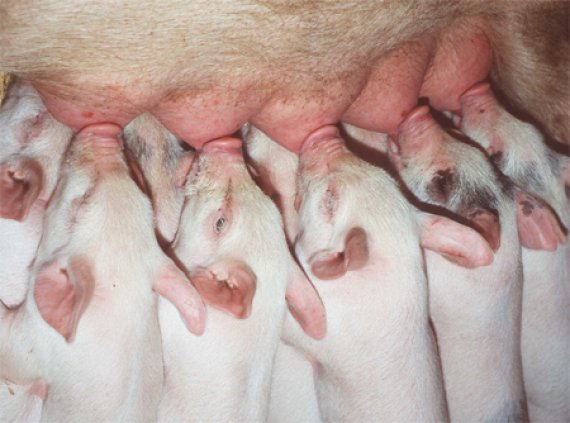For years, about 12.5 percent of the young piglets die in the first weeks after birth, says Vermeer, who just like Kluivers is a researcher at Livestock Research. ‘Most young piglets die in the first four days in the farrowing pen’. Last year, it was shown in figures of Agrovison that piglet mortality even increased to 13.5%. Reason for animal welfare groups to sound alarm.
The increase in litter size of sows – twenty years ago a sow had 11 to 12 piglets, last year 14.4 – plays a large role in piglet mortality. ‘The number of live born piglets is now higher than the number of teats’, says Vermeer. ‘And seeing that piglets have a fixed teat, the lightest piglet is then pushed aside when competing for mother milk.’ The weakest and slowest piglet stays hungry and runs a greater risk of cooling off and being crushed to death by the sow.
The increased litter size is a rat race between breeding organizations in the Netherlands, Denmark and Germany that select their breeding sows on the number of offspring. Because many piglets means more income for pig farmers. Vermeer and Kluivers understand the wish of Van Dam to limit the litter size.
How do you decrease piglet mortality?
Kluivers: ‘By no longer only breed on litter size, but taking into account the vitality of the piglets.’ Vermeer: ‘But that is not enough. Piglet mortality is a multifactorial problem, you need to change multiple things.’
Such as?
Vermeer: ‘You also have to select on maternal characteristics, that they lie down carefully in their farrowing pen and do not crush their piglets. We know from practical research that breeding sows that grow up in a rich environment, with straw and enrichment, later become better mothers. They are mutually more social and take better care of their offspring. That behaviour of the mother can also be adjusted, but we still know too little about this.’
Kluivers: ‘The climate in the barn also plays a role. Shortly after birth the piglets need a temperature of 35 degrees Celsius, and the sow wants 18 to 20 degrees, above this she experiences heat stress. Farrowing pens are actually partially incubators and cooling places for the sow. You have a barn system with a cooling panel for the sow and moveable floors so that the piglets do not end up under the sow.’
Vermeer: ‘But also labour can help. The pig farmers can keep piglets apart when the sow is fed, they can place the piglets in nests, they can handfeed the weakest piglet with formula milk and they can use foster sows for these piglets – in practice this is all already used. But this care costs a lot of time. And you need to imagine that an average company has about 500 sows and has 25 litters on average per week. Thus you need to take care of about 400 piglets a week. The question is whether that time is available. The best option remains to make sure that the sow can take care of her own piglets.’
Does the crisis play a role in the pig farming industry?
Vermeer: ‘You can take it from me that pig farmers do not enjoy the piglet mortality, but they are currently focused on surviving. It would be useful to calculate if pig number 16 or 17 is still profitable. But still you do not spell out mortality with a smaller litter, pig mortality will always remain. Therefore, attention should also be payed to good euthanasia methods and a good euthanasia protocol. Now the farmer needs to call the veterinarian, but that step takes time – which means suffering for the piglet – and money – it is financially not feasible. That is why pig farmers sometimes wait until the weakened pig is dead. For the animal welfare, a good euthanasia protocol is desirable.’

